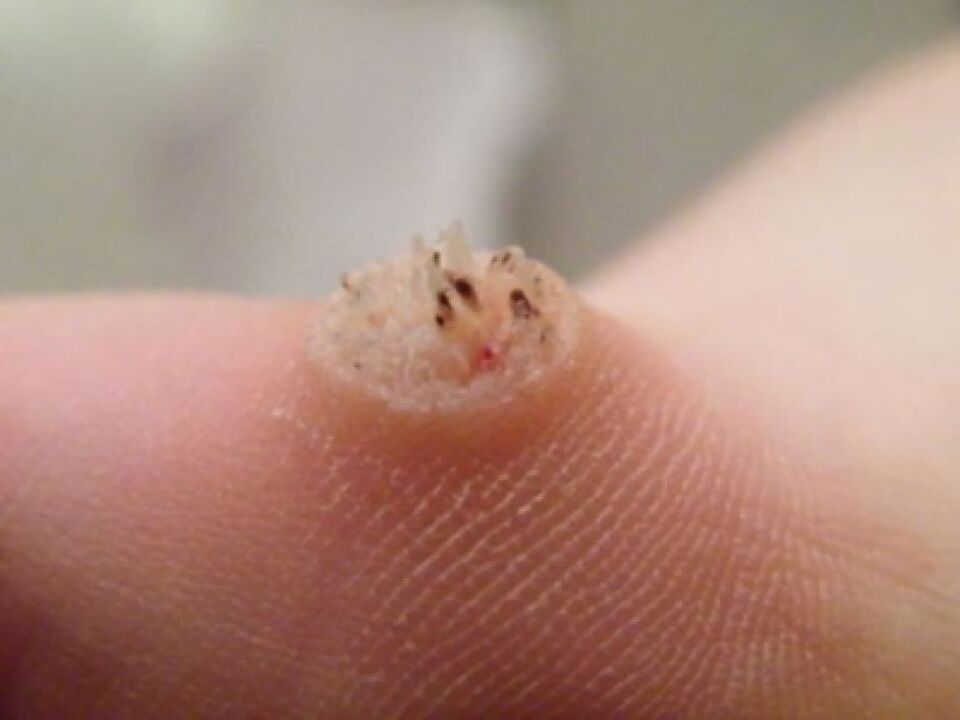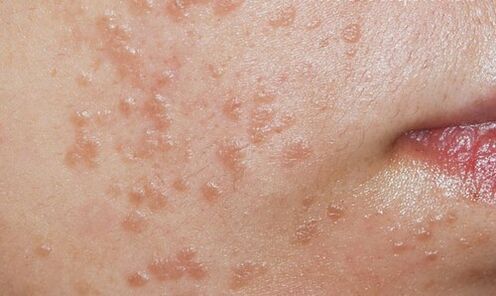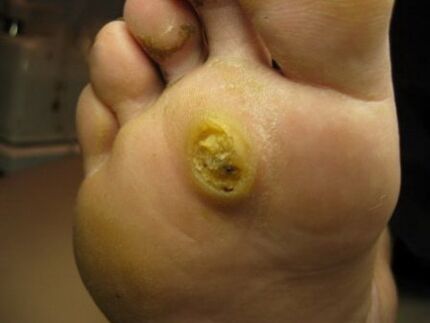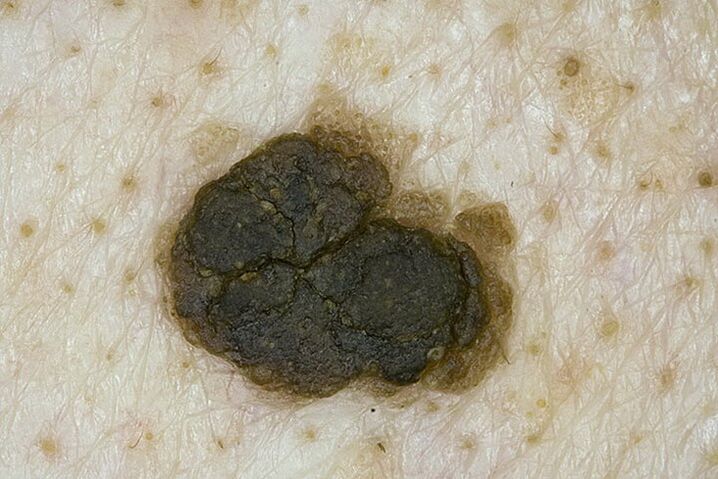Everyone should look at the types of papillomas in general. Such information will be helpful in the sense that certain types of warts have very high levels of oncogenes, and if they appear on the body, see a doctor right away.
Each type of tumor has its own unique external characteristics and is worth exploring a little more.
Description of common or vulgar warts
The carriers of the papillomavirus are 90% of the world's population. For some, it may remain inactive throughout their lives, but there are those who cannot get rid of warts. The most common on the skin is the usual papilloma caused by a variety of viral organisms numbered 7, 10, 12, 14, 15, 17, 19-24, 26, 27, 29, 55.

Papillomas of the vulgar type occur in the human body due to the following external features:
- the shape is round or hemispherical;
- its color is slightly darker than flesh or brown;
- Rises 2-4 millimeters above skin level;
- smooth and smooth texture with a soft texture;
- attached to the human body thanks to its special foot.
Such problems can occur in the arms, legs, back, face, and neck. Some people confuse such benign formations with moles, but in reality, the two concepts are completely different.
Such a problem has no noticeable symptoms, these types of warts have very low levels of oncogenicity and do not require flawless removal. If someone has a desire, they can remove the growth using laser therapy, liquid nitrogen freezing, special patches, or standard surgery.
Description of filiform warts
The types of papillomas can tell you exactly which genotype of the viral organism is causing the problem. Filiform warts are often found on the neck or face. They are quite small, located on long legs and practically do not cause any discomfort. The characteristics of this type of papilloma should be called:
- quite small, almost small in size;
- the legs are long and very thin, resembling yarn;
- meat or light brown;
- quite soft and pleasant texture.
Filiform warts can appear on the eyelids, neck, and near the mouth. If they grow on another part of the body, there is nothing special here because the human papillomavirus can look completely unexpected. Filamentous papillomas are also called anronoreas, and doctors do not give clear recommendations for their removal. For this type of problem, there are no clear recommendations for removal.
Flat papillomas - main features

Flat warts are a fairly common type of papilloma, most commonly occurring at a young age.
Adolescents have small flat warts on their bodies and disappear on their own over time.
The likelihood of flat neoplasm appearing at a more mature age is also quite high because the problem is caused by 43, 55, 53, and some other types of virus.
In terms of appearance, this issue has the following characteristics:
- practically does not extend above skin level or the increase is minimal;
- flesh or light brown hue;
- it most often appears in a single version;
- it does not cause discomfort, it can be minimal or quite large.
Such a problem only causes visual inconvenience because it does not cause any particular problems. Your doctor may prescribe antiviral therapy, which is caused by taking antiviral medicines. If a person experiences visual discomfort in the presence of a flat wart, the papilloma can be surgically removed by laser or cold cauterization.
Pointed papillomas or warts
Pointed papillomas are the most dangerous to humans. 31, 33, 35, 39, 45, 51, 59, 70, 30, 39, 55, 57, 67, 69 are caused by viral organisms. Such formations have very high oncogenic levels, most commonly appearing in the intimate. areas for men and women.
The external characteristics of genital warts due to human papillomavirus activity are as follows:
- cone-shaped growths of various sizes;
- fairly high rise above skin level;
- the presence of the wart is not in a single variant;
- a significant number of papillomas form a formation that is very similar in appearance to cauliflower;
- education not only on the skin but also on the mucous membranes;
- flesh, light brown or pink.
The appearance of these growths in the intimate area causes a lot of inconvenience. The person feels constant itching, feels uncomfortable during intimacy, and may not smell very pleasant.
If a woman is identified with the problem, she is offered to be screened. Treating the problem depends directly on what specific diagnosis doctors make. Once the formations have become malignant, they perform surgery, chemotherapy. In refuting such a severe diagnosis, patients are still advised to remove the growth and perform antiviral therapy.
Plantar warts - main features

Some HPV genotypes cause warts on the soles of the feet and palms. They often resemble the common corn, while being quite painful. The main characteristics of this type of problematic formation are called the following external manifestations:
- color increases are virtually indistinguishable from skin color;
- protrudes slightly above skin level;
- they often resemble a small knot on the leg and have some mobility.
The inconvenience caused by growth only occurs because they appeared in such a zone. Due to over-training, it is painful for a person to step on their feet completely, and if the papilloma is on the arm, there is a great deal of discomfort in the performance of some robot. Such growths must be removed because they can be very easily damaged, often leading to sepsis.
Plantar warts have low oncogenic levels but are quite dangerous as they can be easily damaged without being noticed. In the event of such a problem, antiviral therapy should be performed, and the growth should be surgically removed with laser or liquid nitrogen. A small wound remains after the surgery, but it heals completely within a few days.
Basal-ended papillomas and warts in old age
There are papillomas that occur only in people of a certain age. These types of benign growths include basal-ended papillomas. Such neoplasms are also considered to be warts in old age (pictured).

In terms of appearance, such benign growths can be described as follows:
- its color is practically no different from the usual color of the skin;
- fairly soft texture;
- slight rise above skin level;
- size differences - fairly large or small papillomas.
Such warts are not a danger. They cannot be removed, but if desired, the patient can always choose the most comfortable type of therapy. Papillomas of this type are quite poorly visible in the image, but are well visible in real life on external examination.
further information
There are about 150 types of papillomaviruses in nature that cause warts of different shapes and sizes to appear on the skin. Papillomas are divided into types depending on which strain of HPV is infected.
Warts of different types and sizes can only develop in people after severe weakening of the body, and if such formations are seen on the skin, the following information should be noted and taken into account:
- pointed papillomas or warts that come together always pose a very high risk;
- if warts appear on the soles of the feet, mucous membranes, palms, even if they belong to a safe variety, they must be removed without error;
- do not try to cut off the warts of each type alone, as this threatens relapse and infection of the whole body.
Each human body has its own characteristics that also affect exactly how the human papillomavirus can manifest.
If a person notices a certain type of wart on their body, the description is similar to one of the types listed, see a doctor right away.
If the education does not meet the above descriptions, it should not be ignored either, as all this can be provoked by HPV.
Why is this problem in almost every person? Experienced physicians have not yet been able to identify in detail, but experts have learned how to competently handle both the external manifestations and the source of the problem. The external problem of each variety is an opportunity for a specialist visit. You can’t ignore this because everything can end very seriously.
In custody
So, if a person has ordinary or flat warts, they should not be afraid at all, but sharp growth is not always benign, which is a reason for further diagnosis and immediate treatment.
Senile warts also do not appear in any way and are often not caused by HPV but simply due to age. Flat papillomas can become an age-related feature in adolescents and then disappear without a trace.
But this should not be expected, as the problem could be more serious. It is better to consult a qualified doctor immediately and solve the problem professionally so that you do not encounter any further problems later.
All types of warts include completely safe tumors and ones that can cause significant health damage. Both problems require a competent diagnosis, and only then does the doctor decide what to do in a particular case. Everyone can learn to recognize the types of problem, but there is no point in dealing with it alone.























